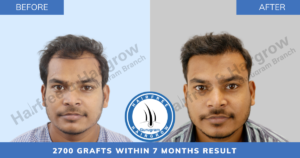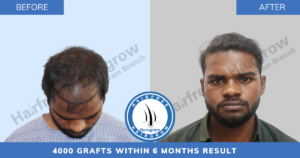Alopecia Areata
What is Alopecia Areata?
 Alopecia areata is a common autoimmune disorder that results in unpredictable hair loss from the head, beard, or any part of the body. It affects regardless of age and gender, though most cases occur before the age of 30.
Alopecia areata is a common autoimmune disorder that results in unpredictable hair loss from the head, beard, or any part of the body. It affects regardless of age and gender, though most cases occur before the age of 30.
It is genetic and passes down in the family. One in five people suddenly over a course of just a few days start to lose tremendous amounts of hair. People with alopecia areata who have only a few patches of hair loss soon recover their hair without treatment.
The condition occurs when white blood cells attack the hair follicles, causing them to shrink which dramatically slows down hair production. It is not known why hair follicles fall in this way, but it progresses rapidly and can cause large patches, thus causing social awkwardness. It is often conjectured that stress could be a probable cause of Alopecia Areata but there aren’t much researches to validate the claim.
Further, it can develop into complete loss of hair on the scalp termed alopecia totalis or in extreme cases the entire body called alopecia Universalis. Corticosteroids, powerful anti-inflammatory drugs that can suppress the immune system can stop white blood cells from attacking the hair follicles. Minoxidil and anthralin can prevent the formation of new bald patches and can even in some cases induce hair regrowth.
Who Gets Alopecia Areata?
Alopecia areata can affect anyone. It affects all racial and ethnic groups equally and affects men and women equally. Although it can start at any age, most people experience it in their twenties, thirties, or teenagers. It tends to be more severe and progressive in children under the age of ten.
Although many people don’t have a family history of the disease, your risk may increase if you have a close relative who has it. Numerous genes have been connected by researchers to the illness, indicating that genetics may be involved in alopecia areata. Many of the genes they have discovered are crucial for the immune system’s proper operation.
Alopecia areata is more common in people with certain autoimmune disorders, such as psoriasis, thyroid disease, or vitiligo, as well as in people with allergy diseases like hay fever.
People who are at risk for developing alopecia areata may develop it as a result of mental stress or a disease, although this is not always the case.
Different Types Of Alopecia Areata
1. Patchy Alopecia Aerata
This form of hair loss, which is the most prevalent, causes one or more patches of baldness the size of coins to appear on the scalp or in other areas of the body.
2. Alopecia totalis
This condition causes people to lose all of their scalp hair, or virtually all of it.
3. Universal Alopecia
Universal Alopecia hair loss This form, which is uncommon, is characterised by a total or almost total loss of hair on the scalp, face, and other parts of the body.
Alopecia Areata signs and symptoms
Although nails might occasionally change, hair is the main aspect of alopecia areata to be affected. The majority of those who have the condition are healthy and show no other symptoms.
Hair Transitions
When alopecia areata first manifests, round or oval patches of hair on the scalp suddenly fall out. However, any portion of the body, including the beard area in men, the eyebrows, and the eyelashes, may also be affected. Short broken hairs or “exclamation point” hairs with a base that is narrower than a tip are frequently seen along the boundaries of the patch. On the exposed portions, there typically is no indication of a rash, redness, or scarring. On some people’s right skin, there is tingling, burning, or itching.
Alopecia Areata Causes
Inflammation results from the immune system wrongly attacking hair follicles in alopecia areata. While the exact source of the immunological attack on hair follicles is unknown, researchers think that both hereditary and environmental (non-genetic) variables are involved.
Hair Loss
⦿ About Hair Loss
⦿ Male Hair Loss
⦿ Female Hair Loss
⦿ Androgenetic Alopecia
⦿ Alopecia Areata
⦿ Traction Alopecia
⦿ Anagen Effluvium
⦿ Telogen Effluvium
⦿ Cicatricial Alopecia
⦿ Folliculitis
Before and After








